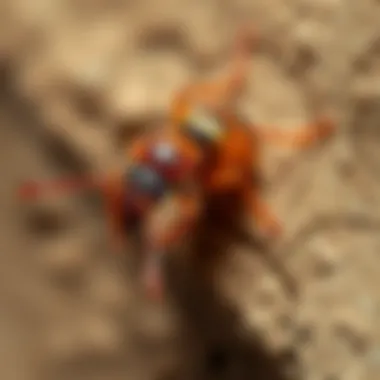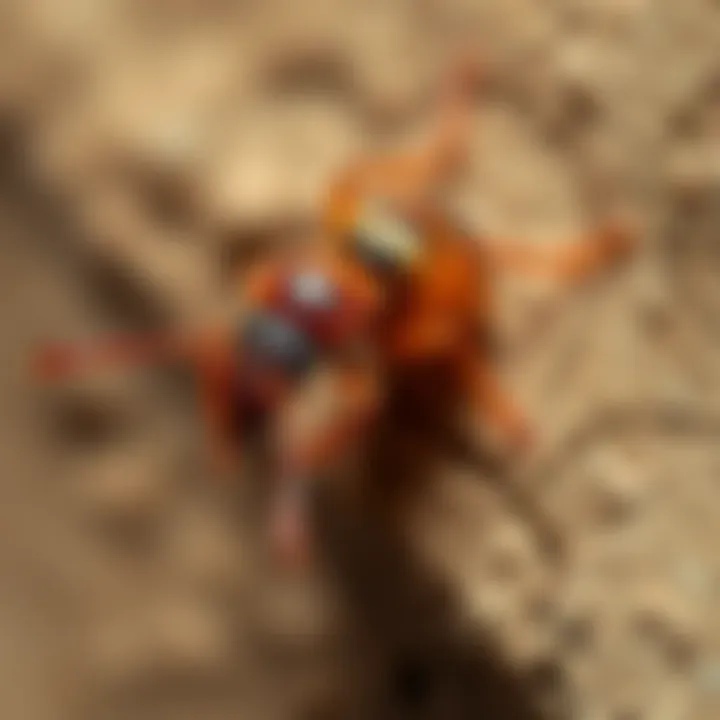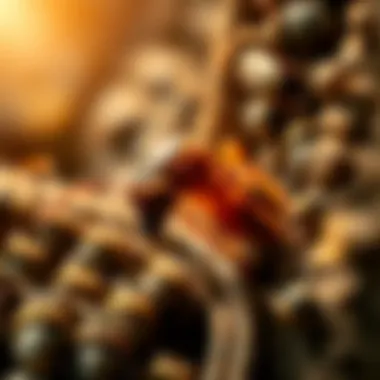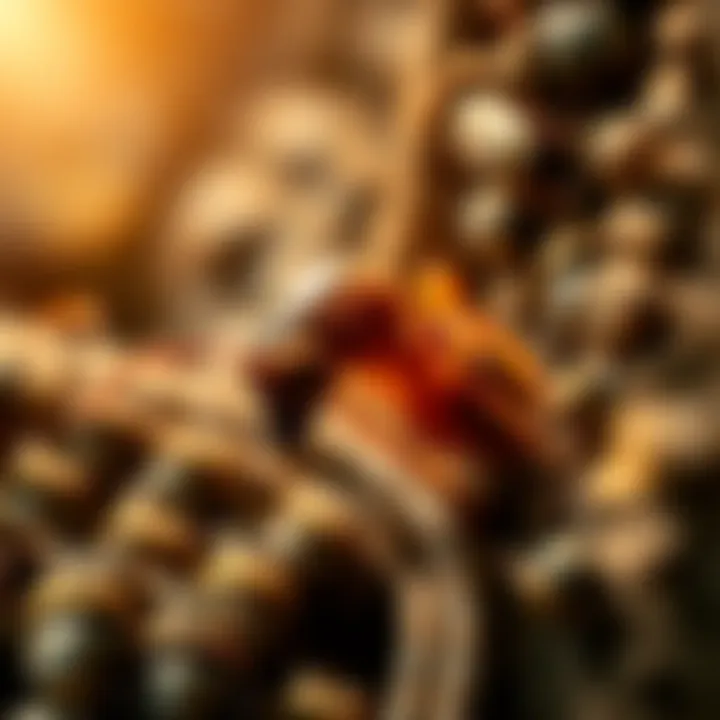Advanced Strategies for Effective Termite Control


Intro
Termites are often viewed through a narrow lens, primarily as nuisances that can wreak havoc on wooden structures. However, understanding the intricate behaviors and habits of these pests can illuminate a path toward more effective control strategies. A detailed exploration reveals not just the mechanics of termite infestations, but also practical methods for prevention and management.
Understanding Pests
Definition of Pests
In broad terms, pests are organisms that cause harm to humans, their interests, or the environment. Specifically, termites categorized under wood-destroying insects, feed on cellulose found in wood, paper, and plant materials. Their behavior is driven by the need to maintain their colonies and nurture their queen, which means a single infestation can escalate rapidly.
Importance of Pest Identification
Identifying pests correctly is crucial. Misidentification can lead to inappropriate treatment methods, which might not only be ineffective but could also exacerbate the issue. Different species of termites, such as the Eastern subterranean termite and the Formosan termite, display varied behaviors and nesting habits. Knowing what you’re dealing with can drastically alter your approach to control.
Prevention Techniques
Preventing an infestation is significantly easier than dealing with one. Simple steps can help protect your home from these destructive pests.
Home and Garden Preventative Measures
- Moisture Control: Termites are drawn to damp environments. Regularly check your home’s plumbing and repair any leaks. Ensure gutters are functioning, directing water away from your foundation.
- Proper Ventilation: Basements and crawl spaces should be well-ventilated. Stagnant air can create a humid environment, ripe for termite infestation.
- Wood Maintenance: Store firewood and wooden materials away from your home. If wood must be in contact with the ground, use termite-resistant wood or treated timber.
Seasonal Prevention Tips
During specific times of the year, termite activity can ramp up. Consider these steps during peak seasons:
- Spring: The mating flight season occurs; inspect any wood structures and use barriers or termite baits.
- Summer: High temperatures can affect wood stability; keep an eye on moisture levels in and around the property.
- Fall: As cold weather approaches, termites look for warmer areas. Conduct a thorough inspection of your home.
- Winter: While activity slows, don’t let your guard down. Regular inspections are essential year-round.
Eco-Friendly Pest Control Solutions
Choosing sustainable pest control methods is in everyone's best interest. Not only do these solutions lessen environmental impact, but they can also be just as effective.
Overview of Sustainable Practices
Sustainable practices could include physical barriers, like metal shields, and biological controls, such as introducing nematodes that prey on termite larvae. These methods provide a safer option for both humans and pets while effectively combating infestations.
Natural Remedies and Their Effectiveness
Many turn to natural remedies in their fight against termites. Some popular options include:
- Borate: A naturally occurring mineral that acts as a poison for termites while being less harmful to humans.
- Essential Oils: Oils from plants like clove and orange have shown effectiveness in repelling termites. Mixing these with a carrier oil can be applied to wooden surfaces as a preventative measure.
"Using eco-friendly solutions not only protects your home but also safeguards the environment for future generations."
Finale
Understanding the behaviors of termites and employing a mix of preventive measures alongside innovative pest control solutions can save homeowners a great deal of stress and money in the long run. Although it can seem daunting, taking a proactive stance not only protects your property but also promotes a healthier living environment.
Understanding Termite Biology and Behavior
Grasping the nuances of termite biology and behavior is vital for anyone dealing with potential infestations. An in-depth understanding of how termites live, reproduce, and feed allows homeowners and pest control professionals to devise effective management strategies. A few key elements underscore its importance:
- Targeted Control Methods: Knowing specific behaviors can help in selecting the most appropriate control techniques. For instance, understanding their social structure can aid in determining when to use baiting systems or chemical treatments effectively.
- Timing of Interventions: Termites have particular life stages that are more susceptible to certain treatments. By understanding their life cycle, the timing of preventative measures can be more accurately aligned for maximum impact.
- Behavioral Insights: Certain species exhibit varied feeding habits. Discovering these nuances can lead to establishing stronger deterrents or control measures tailored to specific species of termites, ensuring a more refined approach rather than a one-size-fits-all tactic.
Ultimately, a comprehensive grasp of termite behavior and biology serves not just to inform pest control practices but also to protect valuable structures against future threats.
Life Cycle of Termites
Termites exhibit a unique life cycle characterized by three primary stages: egg, nymph, and adult. The journey begins with the queen, who can lay thousands of eggs daily. These eggs hatch into nymphs, which resemble miniature adults. In the nymph stage, they undergo a series of molts as they develop into mature termites. The duration from egg to adult can vary greatly, determined by environmental factors such as temperature and moisture levels. Generally, this can range from a few months to several years.
Key Stages include:
- Eggs: Tiny and typically found in clusters, vulnerable to environmental changes.
- Nymphs: They are dependent on the colony’s social structure; some become workers while others may develop into soldiers or alates (winged reproductive insects).
- Adults: Make up the colony's three primary castes: workers, soldiers, and reproductives.
Understanding this life cycle is crucial in timing interventions appropriately, especially when aiming for treatments that target the nymphs before they mature into adults.
Social Structure within Termite Colonies
Termite colonies function with a complex social structure that can be likened to a well-oiled machinery. Each member of the colony plays a role, contributing to the survival and functionality of the group. The main castes include:
- Workers: Often the most numerous, responsible for foraging, caring for the queen's eggs, and constructing the nests. They're the unsung heroes of the colony.
- Soldiers: Their primary duty is protection against predators, such as ants. Soldiers possess large mandibles but are sterile and unable to reproduce.
- Reproductive Members: This includes the king and queen, tasked with reproduction, ensuring the colony’s growth.
The intricate relationships within the colony mean that any disruption can lead to significant consequences, making it paramount for pest control measures to consider the social dynamics. This recognition not only informs targeted strategies but also underscores the need for careful interventions to avoid upsetting the delicate balance within a termite colony.
Feeding Habits and Preferences
Termites are notorious for their wood-eating habits; however, their diet is more diverse than one might think. They primarily feed on cellulose found in wood, leaves, and even some types of soil. Their feeding can go unnoticed until significant damage has occurred.
Factors influencing feeding habits include:
- Species: Different species have preferences; for instance, subterranean termites favor moist wood, while drywood termites can thrive on drier timber without much moisture.
- Seasonal Variations: Some species demonstrate seasonal feeding spikes depending on the availability of resources.
- Environmental Conditions: Moisture levels can impact their feeding preferences; they tend to thrive in humid areas where wood tends to decay.


Understanding these feeding habits is invaluable in creating effective baiting systems or identifying hotspots for potential infestations, thereby enabling proactive management strategies that minimize damage.
Identifying Termite Infestations
Identifying termite infestations stands as a crucial step in preserving the integrity of structures. Homeowners, especially, must recognize the signs early on to minimize damage and save on costly repairs. Termites can silently wreak havoc, and their presence often goes unnoticed until it’s too late. By knowing what to look for, individuals can act swiftly, ensuring proactive measures are in place. This section delves into the key indicators, common species, and modern technologies that aid in detection.
Signs of Termite Activity
Termites are notorious for their stealth; however, certain telltale signs can give you a heads up about their presence. Here are some indicators one should be vigilant about:
- Mud Tubes: These are the highways that termites build to travel between their nests and food sources. Typically found along walls or foundations, if you spot these, it's time to investigate further.
- Discarded Wings: After mating, termites shed their wings. If you notice small piles of wings around windows or doors, this could signal a nearby infestation.
- Hollow Wood Sound: Tapping on wood might yield a hollow sound, indicating that termites have been busy dining within.
- Frass (Termite Droppings): These resemble sawdust and are often found near wooden structures. Spotting this can indicate active or past infestations.
- Swarm Sightings: If you see swarming insects, particularly in the spring, it’s a strong indication of termite activity nearby.
Recognizing these signs can mean the difference between a small nuisance and a full-blown infestation.
Common Species of Termites
Understanding which type of termite you're dealing with can significantly influence your control measures. Here are a few prevalent species to keep a lookout for:
- Eastern Subterranean Termite: This species thrives in moist environments and is often found in the eastern United States. They nest underground and can cause serious damage to wooden structures.
- Formosan Termite: Notorious for being aggressive, these termites are known for their large colonies and destructive capabilities. They can compromise the structural integrity of a home in a short timeframe.
- Drywood Termite: Unlike subterranean species, these termites live within the wood they consume, requiring different detection and treatment strategies.
- Dampwood Termite: They prefer damp wood and are primarily found in areas with high humidity. Spotting them may be easier due to their preference for wood in contact with soil.
Familiarizing oneself with these varieties clarifies treatment approaches and monitoring strategies to implement.
Using Technology for Detection
In today's digital age, there are various technological solutions that can aid in detecting termite infestations:
- Moisture Meters: Since termites thrive in damp conditions, moisture meters can help identify areas with excessive moisture where termites might be present.
- Infrared Cameras: These devices can visualize heat patterns, helping professionals locate termite-infested areas behind walls and in other hard-to-reach places.
- Acoustic Emission Devices: By detecting the sounds made by termites as they chew through wood, these devices serve as a non-invasive way to assess infestations.
- Termite Detection Apps: Some mobile applications can empower homeowners to figure out if they have termites by detailing signs and offering personalized advice.
Incorporating technology, whether through professional methods or DIY apps, enhances the ability to spot termites effectively and act before it’s too late.
By keeping a keen eye on the signs, understanding the common species, and utilizing advanced detection technology, homeowners can better prepare against the lurking threat of termites.
Preventive Measures Against Termites
Preventive measures against termites serve as the first line of defense for homeowners aiming to protect their property. Understanding that these wood-eating pests can cause significant damage undetected for years, it's crucial to adopt comprehensive strategies that minimize risk. Prevention not only safeguards your investment but also provides peace of mind, knowing that proactive steps have been taken to mitigate potential infestations.
Structural Modifications and Maintenance
A well-maintained structure significantly reduces the chances of termite infestations. Here are some practices to enhance durability against these pests:
- Foundation Treatments: Apply a chemical barrier during construction or renovation that prevents termites from accessing the building.
- Regular Inspections: Conduct routine checks for any signs of structural damage or entry points. Focusing on areas like basements and crawl spaces can reveal early indications of an infestation.
- Proper Sealing: Seal any cracks or openings in your foundation, walls, and around utilities, as even small gaps can provide entry for termites.
Maintaining your property’s structural integrity is not just about aesthetics; it’s about ensuring that your home does not become a buffet for hungry termites.
Landscaping Strategies
Landscaping can either attract or repel termites. Therefore, adhering to thoughtful landscaping strategies is essential:
- Distance Plants from Foundation: Ensure that plants and mulch are placed at least 12 inches away from the foundation to discourage termite proximity.
- Choose Safe Plants: Opt for termite-resistant plants like marigolds or lemongrass in your garden, as they can deter these pests effectively.
- Avoid Excess Mulch: While mulch is vital for a healthy garden, too much can trap moisture and offer a perfect environment for termite colonies. Keep mulch to a minimum and ensure it does not contact the building’s structure.
Being mindful about landscaping ensures that your outdoor environment is not inadvertently inviting termites to set up camp next to your sanctuary.
Moisture Control Techniques
Termites thrive in moist environments, making moisture control a fundamental aspect of prevention. Here’s how to manage moisture effectively:
- Good Drainage: Inspect the drainage systems around your home to guarantee they are functioning well, diverting water away from the foundation.
- Fix Leaks Promptly: Tap into your inner handyman and resolve any leaks in plumbing, roofs, or gutters as soon as they arise; even small leaks can lead to significant moisture accumulation.
- Ventilation: Ensure that crawl spaces and attics have adequate ventilation to minimize humidity levels, creating an inhospitable environment for termites.
Controlling moisture in and around your home not only deters termites but also contributes to a healthier living environment overall.
"An ounce of prevention is worth a pound of cure." By instituting these preventive measures, homeowners can safeguard their properties while fostering a resilient defense against termites.
Chemical Treatments in Termite Control
Chemical treatments are a cornerstone in the fight against termite infestations. These strategies are not only effective in eliminating existing colonies but also play a significant role in preventing future invasions. The right chemical approach can provide long-lasting protection and peace of mind for homeowners concerned about the structural integrity of their properties. In this segment, we will explore the types of chemical termiticides available, their application methods, and importantly, the environmental and safety considerations that accompany their use.
Types of Chemical Termiticides
When it comes to chemical termiticides, a variety of options are available, each designed to tackle infestations in different ways. Here are some common types:
- Liquid Soil Treatments: These are usually applied around the foundation of a home, creating a barrier that exposes termites to toxic substances upon contact. These treatments are favored for their immediate effectiveness and long-lasting protection.
- Baits: Baiting systems work by using poison placed in bait stations, which are strategically located in areas where termite activity is detected. Termites consume the bait and carry it back to the colony, effectively reducing their numbers.
- Fumigants: For severe infestations, structural fumigation might be the best approach. This involves sealing the property and filling it with gas that penetrates wood and effectively eliminates termites.
Choosing the right type often depends on the severity of the infestation, the structure's location, and environmental factors.
Application Methods
The application methods of chemical treatments can greatly affect their success. Common application techniques include:
- Trenching: In this method, trenches are dug around the perimeter of the house, and liquid termiticides are poured into them. This ensures that the chemical reaches the soil and forms an effective barrier.
- Drilling: For wooden structures, drilling into the wood may be necessary. This allows the chemical to penetrate deep into the wood where termites are likely to take up residence.
- Baiting System Installation: This method involves setting up bait stations around the property. It's crucial that these are checked regularly to assess their effectiveness and ensure that any new termite activity is detected early.
"Proper application techniques can improve a treatment's effectiveness significantly, reducing the chance of re-infestation."


Impact on Environment and Safety Considerations
While chemical treatments are effective, we must acknowledge the environmental impact and safety considerations. It's paramount to balance termite control effectiveness with ecological responsibility:
- Non-Target Species: Many termiticides can adversely affect beneficial insects and other wildlife. Choosing targeted treatments can minimize this risk.
- Human Safety: Homeowners and pest control professionals must be wary of exposure to these chemicals. Following manufacturer guidelines for safety, using protective gear, and ensuring proper ventilation can help prevent mishaps.
- Long-Term Environmental Health: Prioritizing environmentally-friendly options, like bait systems or bio-based repellents, can ensure that termite control does not compromise local ecosystems.
In summary, understanding the types of chemical treatments, their application methods, and the resulting environmental impact is essential for effective termite management. Each method has its pros and cons, and weighing these against your specific circumstances will guide homeowners in making informed decisions about tackling termite issues.
Innovative Technologies in Termite Management
In the ever-evolving battle against termites, innovative technologies are redefining how we approach pest management. These technologies offer numerous advantages, addressing both efficiency and environmental concerns. Homeowners and pest control professionals alike need to stay abreast of these advancements to ensure structures remain safe from these relentless wood-destroyers.
By employing cutting-edge solutions, identifying infestations before they escalate into significant issues becomes feasible. Additionally, many of these technologies emphasize sustainable practices, allowing for a balanced approach to pest control that aligns with broader ecological frameworks. Below, we delve into three primary innovative solutions that are gaining traction in the field: baiting systems, smart home solutions, and detection and monitoring technologies.
Baiting Systems
Baiting systems play a crucial role in termite management by delivering targeted treatments directly to the pests without broadly applying chemicals throughout the affected area. This approach minimizes chemical exposure while maintaining effectiveness. Unlike traditional methods that saturate an entire site, baiting systems focus on luring termites to their demise.
Typically, these systems consist of bait stations placed strategically around the home. When termites find the bait, they consume it and transfer it back to their colony, thereby affecting a more significant population. Some specific benefits include:
- Reduced Chemical Usage: Limited exposure to toxic substances utilized in traditional pest control.
- Long-Lasting Solutions: These systems can last for many years with minimal maintenance.
- Monitoring Capabilities: Baiting systems often come equipped with monitoring features, allowing for early detection of new activity.
"Baiting systems not only increase efficacy but also help in maintaining ecological balance, offering a nod to sustainable pest management practices."
Smart Home Solutions
Advancements in technology have also brought the ability to integrate termite management into smart home systems. These solutions can enable homeowners to receive real-time updates on potential infestations, allowing for immediate action. Smart technology can include sensors, alerts, and even automated pest control solutions that reduce reliance on manual intervention.
Some of the features of smart home solutions include:
- Remote Monitoring: Homeowners receive notifications on termite activity outside usual visits from pest control experts.
- Automated Treatments: Integrated systems may engage treatments automatically when infestations are detected.
- Data Analytics: Smart systems can analyze patterns over time, helping to predict and prevent future infestations.
Detection and Monitoring Technologies
As one of the critical aspects of termite management, detection technologies have seen remarkable innovations. These developments include moisture detection tools, acoustic sensors, and infrared thermography. Each of these technologies plays a vital role in identifying potential infestations long before they inflict serious damage.
Some methods include:
- Moisture Sensors: Since termites thrive in moist environments, these sensors can help identify areas at risk, allowing for preventative measures.
- Acoustic Detection: By listening for the noises made by termites as they chew through wood, trained devices can prompt interventions before serious damage occurs.
- Infrared Technology: This method educates users on the temperature variances around wooden structures, leading to early identification of termite presence.
Overall, integrating these innovative technologies into termite management practices can offer an edge in controlling and preventing infestations. Adopting these modern approaches allows for a more responsive and sustainable system to tackle the challenges posed by termites.
Biological Control Methods
Biological control methods are gaining traction in the realm of pest management, particularly when it comes to termites. These methods harness the natural enemies of termites, such as predators, pathogens, and competitors, to reduce termite populations in a sustainable manner. This approach not only targets the pest but also minimizes ecological disruption, making it an appealing choice for homeowners who are becoming more environmentally conscious.
The significance of biological control lies in its dual effectiveness: safeguarding structures while promoting the balance of the local ecosystem. Homeowners increasingly seek methods that align with sustainable practices, and biological control meets this demand. By employing natural mechanisms to combat infestations, it reduces reliance on synthetic chemicals, leading to less impact on non-target organisms, including beneficial insects.
Natural Predators of Termites
When it comes to the natural predators of termites, certain species stand out as effective biological control agents. For instance, nematodes are tiny roundworms that can be used as a biological insecticide. When applied to infested areas, these nematodes latch onto termites and introduce a bacteria that eventually kill them. This method has been touted for its precision; it affects termites while leaving other non-target organisms unharmed.
Additionally, some birds, reptiles, and mammals are known to prey on termites as part of their diet. This natural predation can be boosted by creating a conducive habitat for these natural enemies in your yard. For example, if you have a garden that attracts insectivorous birds, it can indirectly help in keeping termite populations in check.
"Natural predation provides a holistic approach to pest control, maintaining ecological balance while effectively managing termite populations."
Fungal and Bacterial Approaches
Fungi and bacteria also play a crucial role in biological control against termites. One notable bacterium is Bacillus thuringiensis (Bt), which produces proteins toxic to certain pests, including termites. When ingested, these proteins disrupt the digestive system of termites, ultimately leading to their death. This method is particularly advantageous because it's highly specific, targeting pests without harming humans or other animals.
Moreover, specific fungal pathogens have emerged as reliable biological control agents. For instance, the fungus Metarhizium anisopliae infects and kills termites. Over time, these spores can provide a long-lasting solution; once introduced to the environment, they can continue to infect new termites, creating an ongoing barrier against infestation.
Incorporating these methods within an Integrated Pest Management (IPM) framework can yield the best results. By combining biological controls with other strategies, such as physical barriers or moisture control, homeowners can develop a comprehensive approach to termite management. The move towards biological control methods resonates with a growing awareness of sustainability, making it a wise choice for those looking to keep their homes termite-free while being gentle on the environment.
For further information on the impacts of biological control methods, you can refer to resources like Britannica or Wikipedia.
Cultural Control Practices
Cultural control practices are crucial in the realm of termite management. These strategies revolve around altering the environment to make it less favorable for termites to thrive. Unlike chemical treatments that temporarily address infestations, cultural practices aim to create a long-term solution. It's like building a fortress around your home rather than just patching up holes when a problem arises. These methods can significantly reduce the risk of termite infestations while promoting sustainable pest management practices.
Community Involvement and Education
Community involvement is the backbone of successful cultural control practices. When neighborhoods work together, they can create an inhospitable environment for termites. This collaborative effort can be achieved through education and awareness. Homeowners engaging in workshops or discussions on best practices for termite prevention foster a sense of community responsibility.
Some effective initiatives include organizing local clean-up events to clear away wood piles or debris that may serve as food sources for termites. Additionally, sharing knowledge about termite prevention methods, such as proper drainage and landscaping techniques, can empower residents to take proactive measures.
A well-informed community is a community that can withstand the threat of termites.
Educating homeowners about the life cycle and habits of termites helps them identify potential risks early on. Informative pamphlets or community meetings can ease concerns and provide essential tips.
Sustainable Practices in Pest Management


Sustainable practices in pest management involve methods that not only target the immediate problem of termites but also consider the overall health of the ecosystem. For instance, promoting natural predators of termites, such as certain birds or nematodes, can create a balanced environment where pests are kept in check without solely relying on chemical solutions.
Homeowners can also adopt practices that enhance soil health. Keeping the gardening space clean and avoiding the excessive use of chemical fertilizers can reduce moisture accumulation, which is often inviting for termites.
Here are some sustainable approaches to consider:
- Use of beneficial plants: Planting species that deter termites can act as a natural barrier.
- Improving drainage: Ensuring water does not accumulate around foundations.
- Wood treatment: Using non-toxic methods to protect wooden structures from infestations.
Evaluating Termite Control Effectiveness
Evaluating the effectiveness of termite control methodologies stands tall as a pillar in any pest management framework. It is not just about applying treatments and hoping for the best. Homeowners and pest control professionals alike need concrete strategies to gauge whether their approaches are yielding results worthy of the investment—both in time and finances. This involves a methodical assessment process that helps pinpoint what's working and what needs tweaking.
Monitoring and Follow-Up Strategies
To effectively monitor termite control, it’s essential to establish a comprehensive follow-up scheme post-treatment. This shouldn’t be a mere afterthought but an integral part of termite management. Regular inspections can uncover any resurgence in activity, potentially saving a homeowner from costly damages down the line. Here are some critical strategies:
- Scheduled Inspections: Conduct inspections at least twice a year. Seasonal checks can help catch new infestations that might arise due to environmental factors such as moisture.
- Use of Monitoring Stations: Installing bait stations can alert you when termites are present. These stations can also be a tool for evaluating the effectiveness of existing treatments.
- Documenting Observations: Keep a precise record of findings during inspections. Noting changes in activity levels or patterns may provide insight into the success of previous treatment plans.
In making monitoring effective, adopting a proactive rather than reactive stance is key. This means staying ahead of the game—and termites.
Assessing Long-Term Outcomes
When assessing long-term outcomes, the focus shifts to understanding the sustainability of termite control efforts. It’s one thing to address an infestation; it’s quite another to ensure that it doesn’t come creeping back. Here are some aspects to consider:
- Longevity of Treatment: Evaluate how long the treatment remains effective. Certain chemical barriers might require reapplication periodically; understanding this can save money and prevent future infestations.
- Structural Observations: Over time, changes to the structure itself might impact susceptibility to termites. Regular assessments of wood conditions and structural integrity will provide insight into whether external factors may be fostering new infestations.
"The best defense against termites is not just a one-time treatment but continuous vigilance and adaptation."
By tracing the outcomes over time, homeowners can adjust their strategies, ensuring peace of mind knowing that their homes remain safeguarded.
Through a comprehensive evaluation of termite control effectiveness, the relationship between treatment methodologies and long-term sustainability becomes clearer. This equips homeowners with the knowledge to make informed decisions and maintain structural integrity against those persistent little pests.
Expertise and Professional Resources
When it comes to controlling termite infestations, the knowledge and expertise of pest control professionals can make all the difference. The right specialist does not just eliminate existing pests; they provide valuable insights into preventing future issues and safeguarding your property. Homeowners cannot overlook the significance of choosing a well-trained technician who understands the nuances of termite behavior and the latest control methods. This expertise is not just beneficial—it’s essential for effective pest management and ensuring the longevity of your home.
Choosing a Pest Control Professional
Selecting the right pest control professional is critical in the battle against termites. Here are some key factors to consider:
- Experience Matters: Look for a company with a solid track record in termite management. Professionals who have handled various cases are better equipped to deal with unique infestations.
- References and Reviews: Don’t shy away from asking for references or looking up reviews online. Reputable companies will have satisfied customers and positive testimonials, attesting to their efficacy.
- Service Range: Different companies offer different services. Some might specialize in chemical treatments, while others might focus on baiting systems or biological control. Understanding what they offer can help in making an informed decision.
- Inspection Protocol: A good pest control professional will provide a thorough inspection before recommending treatments. This is critical, as it allows them to tailor their approach to your specific situation.
Ultimately, choosing a knowledgeable and reputable pest control professional is the first step toward ensuring your home is well protected from termites.
Certifications and Training Programs
Certifications and training programs for pest control professionals play a pivotal role in the quality of services they offer. Here's why they are important:
- Credibility: Certifications from recognized organizations demonstrate that a pest control technician has undergone rigorous training and adheres to industry standards.
- Current Knowledge: Pest control is an evolving field. Continuous education through training programs ensures professionals stay updated on the latest developments, including new treatment methods and safety practices.
- Ethical Standards: Certified professionals are often required to follow a code of ethics. This ensures they conduct business fairly, prioritize customer satisfaction, and minimize environmental impact.
In summary, both choosing a qualified pest control professional and ensuring they have the proper certifications can significantly enhance the effectiveness of termite management strategies. As you prepare to safeguard your home against these wood-destroying pests, take the time to research your options.
"Quality pest control isn't just a service; it's peace of mind for homeowners that they are shielded from the lurking threat of termites."
In the realm of termite control, investing in expertise pays off. After all, preventing a termite infestation or dealing with one effectively calls for knowledge that only trained professionals can provide.
Future Trends in Termite Control
As homeowners and pest control professionals look towards the horizon, understanding future trends in termite control becomes essential. The stakes are high, with termites costing billions annually in property damage. Being proactive with advanced strategies is of utmost importance for maintaining the integrity of structures. This section will shine a light on ongoing research efforts and the innovative technologies shaking up the termite control landscape.
Ongoing Research Efforts
The realm of termite control is constantly evolving, as scientists and researchers dig deeper into the lives of these pests. Recent studies focus on the biological specifics of termite lifecycles and behavior. By unlocking more mysteries about their habits, researchers aim to develop targeted control measures. One promising area of exploration is the genetic manipulation of termite populations to reduce their reproductive rates. This is particularly fascinating as it moves away from traditional chemical approaches and leans into biological and ecological solutions.
Moreover, research into pheromone traps continues to evolve. By understanding the chemical signals termites use for communication, pest control experts can design traps that exploit these signals, leading termites into devices that eliminate them safely and effectively.
- Genetic Manipulation:
- Pheromone Traps:
- Scientists are investigating ways to alter termite genetics to suppress infestations.
- Utilizing termite communication for better trap designs can improve efficacy.
These ongoing research efforts highlight the shift towards sustainable practices and underline the importance of staying updated on scientific advancements in pest control.
Evolving Technologies and Methods
The future is brimming with promise in terms of technology in termite control. The integration of smart home technology is leading to more effective infestation management. For instance, sensors that detect moisture levels can trigger alerts for homeowners, as termites often thrive in high-moisture environments.
Interestingly enough, drone technology has begun to carve its niche in pest control as well. By using drones equipped with thermal imaging, pest control professionals can scan properties for below-ground termite activity. This ability to pinpoint infested areas allows for more targeted treatment and less impact on the surrounding environment.
Another noteworthy trend is the development of biodegradable termiticides that promise to deliver effective pest management while being environmentally friendly. These substances break down naturally over time, mitigating adverse effects on the ecosystem.
- Smart Sensors:
- Drones in Pest Control:
- Monitor moisture levels to predict potential infestations.
- Advanced imaging technology aids in locating infestations with high precision.
"The use of smart technology and drones represents a remarkable step towards a future of pest management that is more effective and less harmful to our surroundings."



